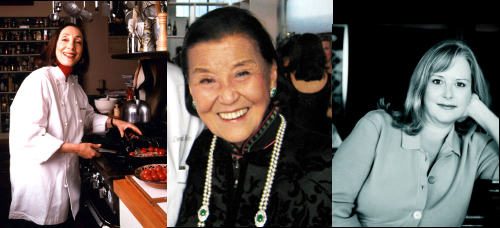Like many successful women who have weathered the ups and downs of a demanding profession, they get a little tired of being classified as "women chefs." However, this profession is still one that's dominated by men, and it was much more so back in the 1960s, when all three were starting out. But it helped to be in San Francisco. Said Joyce, "The Bay Area was always progressive. Banks here would lend women money. There were a lot of women entrepreneurs, women running businesses in the city." Now, she says, there are a lot of women in the wine business, women not just working as pastry chefs but running their own bakeries, manufacturing their own jams and confections, running businesses rather than just cooking at home for fun.
Chiang had a different experience, trying to break into what was then a very insular, Cantonese-dominated Chinese food world. Said Chiang, "I was a woman, and restaurants weren't a women's business. I can't speak Cantonese, and then 90% of the Chinese-restaurant population spoke Cantonese. I would speak Mandarin to them, and they'd laugh at me, be very insulting, treat me like a foreigner. I couldn't get credit at any of the produce, fish, or meat markets in Chinatown; I had to pay cash for everything. The Americans were so kind, they accepted me, but not the Chinese, because I was a woman."
Now, said Nancy, women in the business are competing on a level playing field, especially here in the Bay Area, where there's more diversity, and kitchens are less dominated by the European boys' club common in New York restaurants. So, why do male chefs still get the lion's share of press and notoriety?
"Well, besides Gabrielle Hamilton, who keeps her end up being outrageous, most women chefs don't feel they have to be potty-mouthed in the school of [Anthony] Bourdain and [David] Chang, traveling in packs and dropping f-bombs. Women do this because we like the work, not to be a celebrity."
Between the three of them, they've seen a lot of trends come and go. Foraging, for example, is nothing new. Back in Chez Panisse's early years, Nancy remembered Alice Waters and pastry chef Lindsey Shere constantly picking through the Berkeley backyards of their friends and neighbors, making poundcakes scented with rose geranium leaves, plucking nasturtium blossoms and purslane for salads. "I keep learning," noted Nancy. "I'm not a chemical-food or foam advocate, but when you've got a bunch of 23-year-olds in the kitchen who are excited about this kind of thing, well, I go to Le Sanctuaire, we get out the gels and the foams and see what works, what will really be worth eating, what will stand the test of time. I think you need 100 years to really create a cuisine. How long has it been for California cuisine, 30, 40 years? We're still finding out what will last."
"When I was first starting out, I needed a lot of ingredients that the Cantonese don't use. No one carried them; I had to get everything shipped in from Taiwan. Now, you can get anything in Asian markets, things from all over," said Cecilia. She's less impressed with the quality of Chinese restaurants in the Bay Area now. "The cooks aren't professionally trained, they don't have passion. It's just a business." As a restaurant-owning friend pointed out to her, a restaurant can make so much more money off hard liquor and entertainment, like karaoke, there's little incentive to invest in high-quality ingredients or top-notch chefs.
"There's been so much progression in Mediterranean food. It's much more about specific cuisines now," noted Joyce. Restaurants don't just serve Italian food, they serve Roman, Sicilian, or Sardinian food. And the quality of up-and-coming cooks is higher, too. "Everyone's going to cooking schools, doing stages...they don't always have the palate or the passion, but they do have the skills."
What do they miss? The California-meets-Chinese cuisine of the late Barbara Tropp, for one, whose China Moon Cafe has never been equaled. "She was a scholar, extremely meticulous, doing Chinese cooking with California ingredients. No else has picked up on that, to the degree that she was doing," said Joyce.
And where do they go now? Commonwealth, said Nancy. "I like the great spirit there, the service, the wine list where I never recognize anything but always find something interesting, the fact that 10% of the cost of the tasting menu goes to charity." Goldstein agreed. Normally suspicious of tech-y modernist cuisine, she said, "I was pleasantly surprised! Jason Fox understands texture, he understands flavor, and they understand hospitality. I feel the same about Nopa. I bring people there from out of town. Yes, it's boisterous, but the food is solid and grounded, and I love the wine list. Perbacco, too, because I always learn something. And because I like to see the chef actually in the restaurant, in the farmers' market." Gary Danko, says Cecilia. It's very consistent, and the prices haven't changed. She likes Benu, too, and Prospect.
